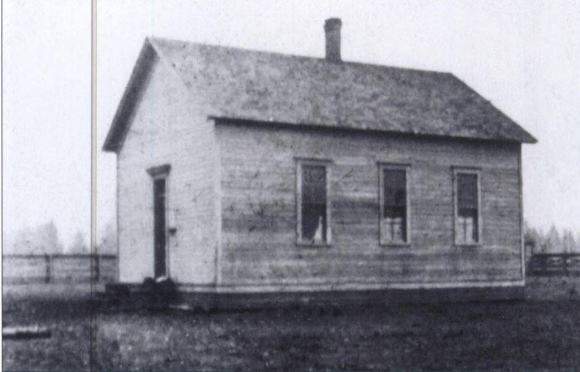Tacoma Public Schools is the fourth largest districts in Washington, behind Seattle, Spokane and Lake Washington. It serves about 30,000 children in preschool through 12th grade and has 35 elementary schools, 11 middle schools, 10 high schools and four early learning centers. Reaching a graduation rate of 89.6 percent, the Tacoma School District’s Class of 2019 witnessed its most successful year since the State began tracking the statistic in 2003.
But how did the district and public education start in Pierce County?
The first formalized classes ever held in what is now Washington state were held in the Nisqually Methodist Mission. The humble building was located near the Hudson’s Bay Co. operations at Fort Nisqually in present day DuPont. The teacher was Chloe Clark, but the mission only lasted two years, from 1840 until 1842. The mission didn’t do all that well in converting the Native Americans of the area, so it was simply abandoned. But it did mark another first in history. It marked the first wedding of American citizens in Western Washington. Clark married William Willson, who would later go down in history as the founder of Salem, Oregon.
The elementary school in DuPont is named in Clark’s honor to mark the milestone of her bringing education to the region, but those classes were more religious in nature than your typical public education. Keep in mind that their Methodist Mission came and went almost a full decade before the American settlement of Steilacoom and the Army base of Fort Steilacoom were ever created, so it is not like they were teaching settler children.

Education for the children from the growing numbers of settlers to the area would start in 1854 in a two-story log cabin on the banks of Steilacoom in 1854.
It was the home of Rev. John F. DeVore and wife Jane, who founded and ran the nearby Methodist Church. Lydia Anne Bonney conducted classes in their living room during the school year, which ran in July, August and September that year. She is therefore honored as being the first public school teacher north of the Columbia River and why Steilacoom is designated as School District #1 within Washington State.
During the Indian War of 1855-1856, the log-structure-turned-schoolhouse also became a blockhouse that provided safety in case of an attack, an attack that never came. Regardless of that fact, the children kept their trinkets and books tied in handkerchiefs – ready for quick removal – and many of them had hiding places picked out beneath logs in the woods both for their belongings and themselves, in case the Indians overran their school.
Hostilities ended in mid-1855, and a treaty was signed in 1856. Calm returned to the land. The end of the Indian War brought an influx of settlers to Puget Sound, and they had children. They needed schooling. But they were farm folk, and Steilacoom was a metropolitan center that was far from the homesteads. That fact made it difficult to get kids to school on time.
In 1855, the first purpose-built school north of the Columbia River was constructed at the current site of Park Lodge School in Lakewood. Lumber from Andrew Byrd’s Lumber Mill at Lake Steilacoom was donated to construct the one-room schoolhouse. The school drew children from as far east as Spanaway and Fern Hill. The Byrd School was moved a year later to a more central location on land donated by W. P. Dougherty. The one-acre site was on the southwest corner of his land claim, property later known as the Flett Dairy. It is now the corner of Steilacoom Boulevard and Lakewood Drive. The school was rebuilt and expanded in 1861 and remained in use until 1885, when it burned to the ground.

The site laid undisturbed for more than a century, until it was excavated by members of the Lakewood Historical Society in 1999 as the site was preparing to become an apartment complex. The oil lamps, nails, hinges and candle holders that were found are now on display at the Lakewood History Museum.
Formal school district’s mushroomed around the region as the Territorial Legislature enacted a property tax to fund schools rather than having communities gather donations.
The area kept growing so a more formalized educational system was needed. Tacoma School District No. 10, given its name as the 10th district in the state, was largely influenced by a new influx of European immigrants. Many immigrant families, primarily from eastern and southern Europe, for example, were from rural areas and struggled to adapt to a more urban way of life. This focus on the civic responsibilities of schools resulted in the improvement of libraries, lunchrooms, administrative offices and other rooms designated toward providing the necessary space to address community concerns.
James P. Stewart is noted as Tacoma’s first teacher, for serving the first year in 1869. A middle school is named after him.
The Pierce County Board of Education formed. Its first superintendent was Clara McCarty. She also holds the distinction of being the first graduate – male or female – of the Territorial University, now known as the University of Washington. She was one of 17 freshmen and the only one to graduate. She is also noted as the first woman to hold elected office in Pierce County.

She had earned a bachelor’s degree in science in June 1876 and taught classes for a few years and then attended the University of California before returning to the area. On November 2, 1880, McCarty was elected Superintendent of Pierce County Schools. She was 22 years old. She supervised the schools in Tacoma, Orting, Sumner and Puyallup. She then married John H. Wilt in 1882 and opted out of seeking reelection. Her successor was also a woman – Cornelia Greer. A University of Washington dormitory, built during the construction boom of the 1960s, was named in her honor. McCarty Hall was torn down in 2015. It has since been replaced with a new hall that also bears her name.
As the county seat and the South Sound’s most populous city, Tacoma’s school district grew as the city grew. What is now the district’s central administration building started its life as Tacoma High School, which operated from 1896 to 1906. It was also the site of the short-lived Washington College for Boys, which operated from 1885 until 1896.
Wood schoolhouses in neighborhoods were proving too small. Concrete structures then sprung up. John Rogers Elementary School, built in 1907, holds the distinction as the district’s first concrete school building. Noted architect Fredrick Heath designed the building while he was also retrofitting the failed hotel project that is now Stadium High School as well as the Pythian Temple and a host of other buildings. Rogers operated for generations before being closed in 2002. It was most recently renovated to be Destiny Middle School, a charter school that closed after only three years of operation. It is now vacant again.

What is now Jason Lee Middle School, started out as West Intermediate School. It was the first and largest of six intermediate schools funded in 1923. It was created on the former campus of the College of Puget Sound (now the University of Puget Sound) at 6th Avenue and North Sprague Avenue by architect Roland E. Borhek. The school was named after the notable Methodist missionary and pioneer Jason Lee.
Now, the story of how UPS moved to its current location is a bit of an interesting story that reaches just outside of the City of Destiny. The University of Puget Sound was founded in 1888 by what is now the United Methodist Church. The idea for a private college in Tacoma originated with Charles Henry Fowler, who had previously been the president of Northwestern University. Fowler was in Tacoma for a Methodist conference when he spoke of his vision of a Christian institution of learning in the area. In September 1890, UPS opened its doors, taking in 88 students.
Enrollment grew, so the university wanted more space. Administrators purchased land on a waterfront site just west of town. Those plans fizzed, however, after it was determined that the site was too far away from downtown Tacoma. That land was sold to raise money for another site before then finally settling on the current North Tacoma location. That news disappointed education-seeking settlers of that area. They had already given the neighborhood of the would-be campus a name, University Place. It’s a name that survived until it was formalized in 1995, when the area became a city.



































